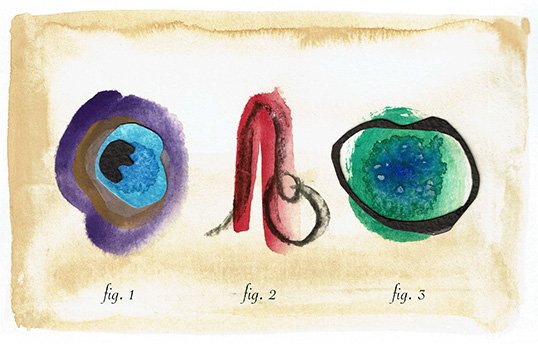I have no doubts about the following four characteristics. Firstly, the gap is dark, so dark that it is hard to describe as anything other than black. Secondly, and regrettably, it is also bottomless. In addition to this it has walls, resembling not the cosmos or the sea beneath its surface, but a kind of tunnel, or, more precisely, a well; because the last thing of which I am certain is that the gap extends in one fixed direction—downwards.
The reader may argue that subjective phenomena escape objective description. However, it is not objectivity that I seek, but precision; the subjective nature of the gap is the very reason why a description is so necessary. What inspires the incurably ill patient’s obsession with the precise term for her diagnosis? What exactly is it about the personality of the aquarium fish that changes in the moment we christen it Birdseye?
If you chopped off my leg or switched my heart with a donor’s, I would still be me; without the gap, I would be someone else. It’s been this way since I was twelve years old. Even so, I’ve spent a number of years convinced that I’ve come to feel better: the gap has been less persistent in day-to-day life, there’s no doubting that fact, and it’s taken on an unassuming, almost well-mannered role in the background, or rather, on the fringes of my consciousness, as if it might one day accept being forgotten, or, a little less drastically, accept being remembered the way one might recall a bout of cystitis or an ordinary compulsive thought. On those rare occasions when it has gained the upper hand and thrust its way to the fore, I’ve found myself left with the sense that something was no longer quite as it used to be, that the gap had become a touch narrower, more constricted, enough to give me notions of wriggling away, clinging onto something, stopping the fall. But the convex hull will always exist.
That last sentence is a result in set theory. In this context, it is entirely irrelevant. It can articulate nothing about the future, the shape, or even the width, for that matter, of the gap that exists within me. Set theory is concerned with sets, while the gap is nothingness. What’s more, the theorem is in no way concerned with holes or gaps. Even so, it has become inextricably bound to my own perception of the gap, an integral part of this perception: a false association no doubt established partly due to my own inability to describe the gap any more precisely, combined with a translation slip-up (to which I will return shortly) and the infinite fear that love is only evident in, and really nothing but the result of, false associations and translation slip-ups.
A convex set is defined as follows: if two points, x and y, lie within the set, then all points on the straight line between x and y also lie within the set, like so:
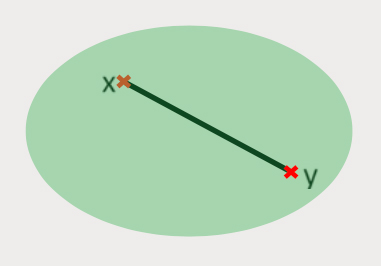
Fig. 1
But not like so:
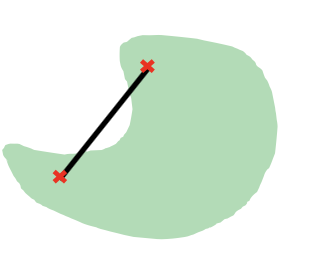
Fig. 2
The ‘well’ metaphor suggests that the gap’s cross section might be represented as follows:
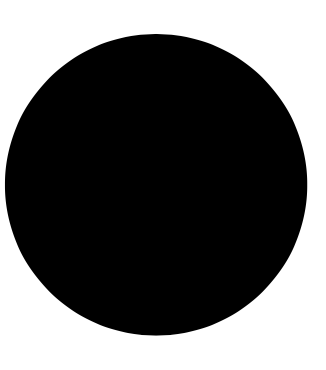
Fig. 3
The black area in Figure 3 constitutes a convex set. The walls of the well are not included in the illustration; it is the gap that I am addressing here, not its perimeter.
A set that does not contain any of its boundary points is known as open. Thus, I may appear to have found a description, if not of the gap itself, then at least of the form of its cross section: a convex, open set, open like a brain without a skull, without skin.
Given the ‘well’ metaphor, the gap as a whole (by which I mean its form, since the gap itself is not a set, but an unbearable void) might also conceivably be described as a convex and open set. (Given that the gap is bottomless, the set must also be unbounded; but my God, if the gap were closed and bounded, I’d hardly be describing it as a gap, would I?)
I am in no way reassured by reading what I’ve written above. After all, these are ridiculous oversimplifications. The cross section of an ordinary well would more precisely resemble something like this:
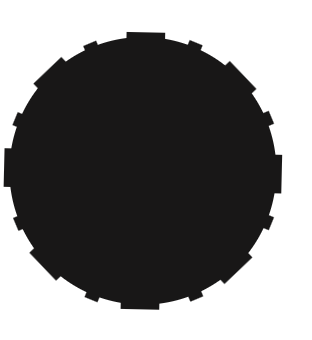
Fig. 4
And the depth of the well at which the cross section is taken would make a difference, of course, with the stones laid at each precise point. Let’s imagine that we take a cross section at every half-metre on the way down; none of these cross sections would be identical, perhaps none of them would even be convex (the set in Figure 4, for instance, is definitely not convex). And if this is true of an ordinary well, what can then be said for the gap, which has an endless number of cross sections, even if limiting oneself to counting one cross section for every half-metre: the gap is bottomless, why should all of these cross sections be even approximately similar? It seems far more likely that they would have curves and bulges like this, for instance:
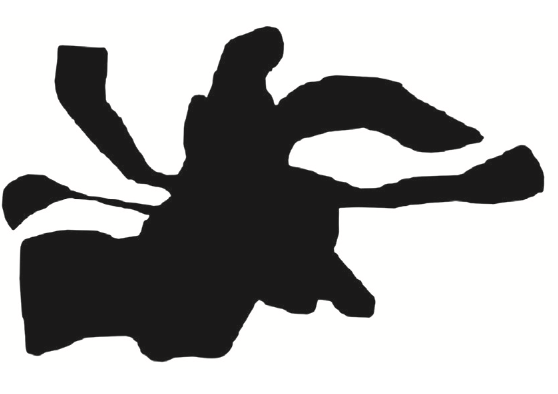
Fig. 5
And a little further down, or up, for that matter:
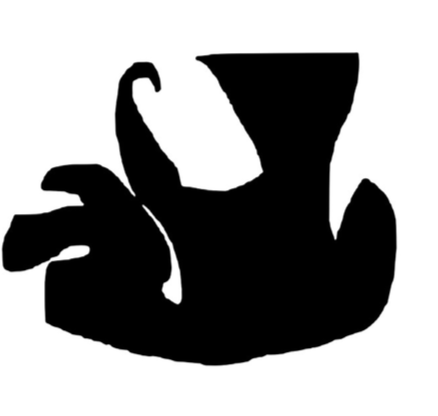
Fig. 6
The sets in Figures 5 and 6 are not convex. Even so, there is something known as the convex hull of a set; and not only does it exist, but it will always exist.
Let me explain. Start with any set, such as the green, crescent moon-shaped island in Figure 2. Let’s call it Isle. An island of its kind does not constitute a convex set, the little indentation at north-west ensures this fact—we can extend a line straight across it, a line that ends up in the sea and which, therefore, is not part of Isle. But the convex hull of Isle does exist, so what exactly is this? As the word ‘hull’ might suggest to the reader, it is an encirclement, an embrace, as if to remind us that love is more than just sex: the convex hull of Isle is the smallest possible convex set that contains Isle. Thus, Isle plus the small indentation at its north-west point, approximately so:
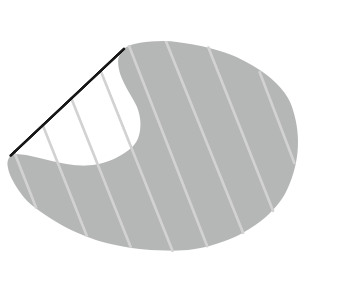
Fig. 7
This is where the translation slip-up comes into play: at some point or another in time, someone—whether the author of a textbook, or a lecturer, or a tutor, or perhaps even me personally—must have translated the phrase convex hull to Norwegian as konvekst hull, without realising the fundamentally different meanings of the word hull in English and Norwegian. The Norwegian mistranslation describes a convex hole, rather than a convex hull. I only wish that someone had told me that the concept centres around the idea of a hull, the part of a ship that envelops it and keeps the water at bay, the part that allows the ship to stay afloat; perhaps then I might have envisaged from the start that the gap might one day disappear, and if not from the start then at least by the time that I embarked upon my studies, envisaged that it could disappear not just from my memory but from my body, from the world! It was only later that I discovered the fact that numerous mathematicians and economists prefer to use a Norwegian term that translates as convex envelope, which is hugely preferable to the inaccurate convex hole. Nevertheless, the false association had long since been established in my mind.
Below I have drawn the convex hull, or rather, the embrace of the island in the Seychelles known as La Digue:
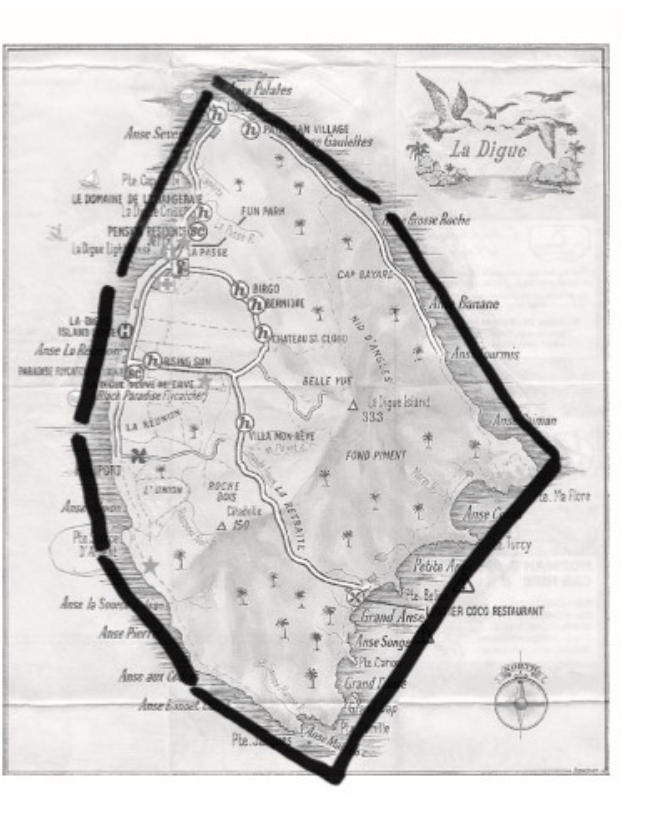
The fact that north is located at the top of the map is no more than an arbitrary convention. If I turn the map around, I think the convex hull of La Digue resembles the hull of a ship, a cross section taken at elevation, viewed straight on, or even from the back, for that matter:
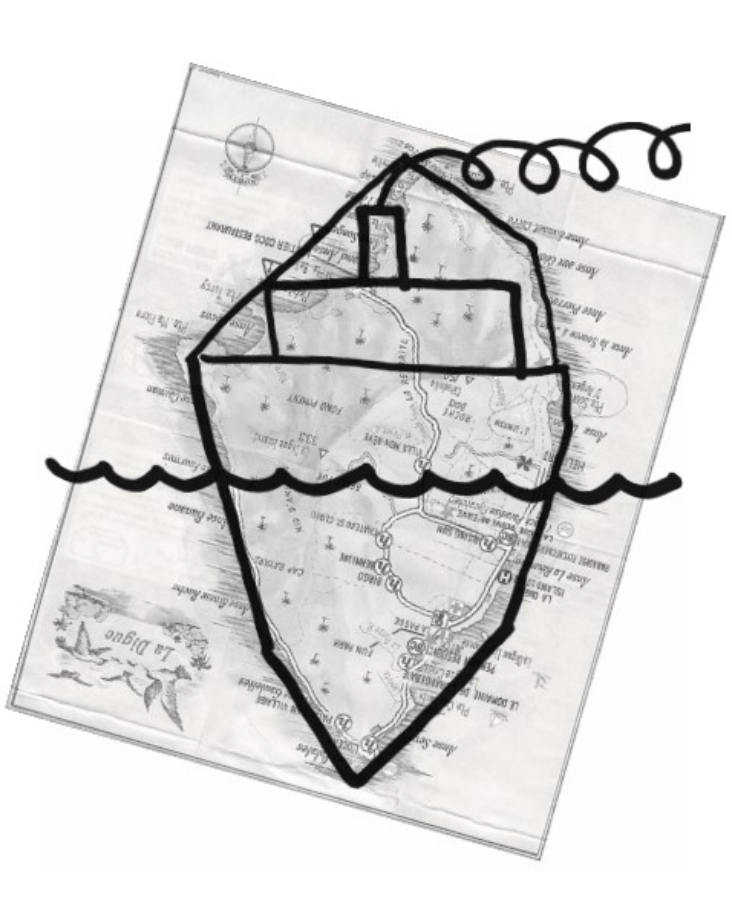
The heatstroke that caused me to faint occurred when we were on the west side of the island, after we had left our bicycles behind to walk the final kilometre to Pte. Source D’Argent. As we had cycled the air had seemed cool, friendly, the wind in my hair, the sweet fragrance of vanilla from nearby plantations on the breeze, rays of sunlight splintered by the leafy canopy overhead; it now became clear that any breeze we’d felt had been a result of the speed we had been cycling, that we were close to the equator in 80 percent humidity, that I was wearing no sun hat. You can’t wear a sun hat when you’re cycling.
The path inched onwards in relentless white twists and turns. It was lunchtime. We hadn’t eaten. J walked ahead of me and I thought of the water at the north-west of the island, the sea we had snorkelled in that morning: the boat like a bird, drifting on the surface of the expanse of blue that extended out and down, towards something darker, something living; swimming over the rising coral, I had seen the reef disappear beneath me, a steep wall with storey upon storey of fish, aquatic cities, and beyond that: this vanishing blue.
J walked ahead of me along the path. We couldn’t turn around. I called out to him that it was good to get some exercise. My head felt large. It didn’t seem wise to let it grow any larger. All in all, it seemed crucial to keep moving, to cool off in the water, to find some shade beneath one of the large boulders.
The sun had reached its zenith. All of the small, black patches of shadow to be found were already occupied by others. We walked and walked and eventually undressed in the full glare of the sun before running out into the water, which was hazy, bath temperature, endlessly shallow, the seabed hardly sloping at all; I threw myself onto my back and stared up at the sky, the light stinging my eyes, the hair at the nape of my neck scarcely growing damp. It was on our way back to our bicycles that I fainted. I should have seen it coming. It was fortunate, in spite of everything else, that one of us remained on our feet.
He must have caught me as I fell. It didn’t hurt. I opened my eyes and saw slim branches and a face, its expression grave, hair grey. I was beneath the surface, in the darkness; I was twelve years old.
I’ve fainted a few times, but only the first time was on purpose. I was twelve—before I fainted, that is, though not when I woke up, I was much older when I woke up—and I’ve never been twelve again, not since that point, not until I woke up that day on La Digue with the slim branches up above and that face hovering over me.
We were on a school camping trip in the mountains and had just learned how to dig into the snowdrift in case we ever found ourselves stranded in an emergency. The snow holes we’d created in the walls of the drift were deep, with low, narrow entrances to keep the cold air at bay.
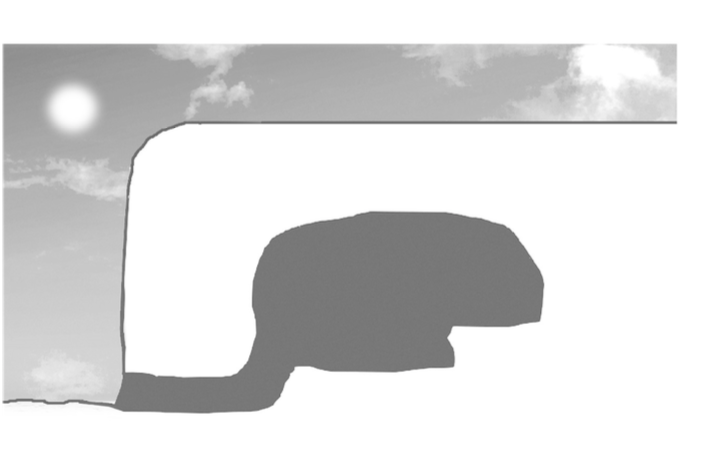
The sky was blue, like the equatorial sky at noon. We had been sitting on the snow bench deep inside our snow hole, eating our packed lunches as if it hadn’t occurred to us that the roof might collapse in on us at any given moment; we had wriggled our way through the cave’s birth canal and out of the hole, which probably explains the sense of abandon that gripped us in the aftermath, making us bold and joyful, and the teachers too, who were persuaded to let some of us girls remain up there for a while on our own. Or perhaps it was the other way around for me: perhaps emerging from the hole, rejoining the world, perhaps that was what I couldn’t bear. At any rate, I recall watching the rest of the class disappearing over the crest of the hill far below us like marching ants, their ski tracks glistening in the afternoon sunlight.
In the fresh snow outside the holes we carried out our first experiments in self-medication, or rather, self-treatment, since breathing techniques and the brute force of our bodies were our only remedies. I remember the prickling sensation around my mouth as I sat there, leaning forwards, panting like a dog, and my helplessness as I swept my arms up into the air and threw myself backwards, out of control, out into the blue and white; I remember the arms that caught me, enveloped me, forcing the air out of me with the desperate care of a twelve-year-old.
A boyfriend I had later in life, during my teenage years, claimed that I looked tenser when sleeping than I ever did awake. It’s not all that strange, really. We are still ourselves in our sleep, our gaps don’t disappear; however, maintaining any kind of pretence is only possible when we’re awake.
Fainting is entirely different. Who are we when we faint? Fragments of memories linger when we come round, and those fragments are nothing like dreams.
I lay in the snow and saw four heads hovering over me, huddled close, unrecognisable against the backlight. One of them giggled. Another whispered: What was it like? And the gap had always been present, although somehow confined, manageable, a black blot to be avoided; it didn’t emerge at that point. But there, in the snow, I saw that it was bottomless, and it happened when I awoke, not while I was gone, because in the unconscious there was no gap.
I was twelve years old. I opened my eyes under the blue sky of the equator, and upon seeing the hair colour of the person leaning over me, I realised that I had grown old. He removed his sunglasses, moved closer. He said something. He grasped my arm. And I understood then that the convex hull isn’t a hole. It is an embrace: that is why it will always exist.

